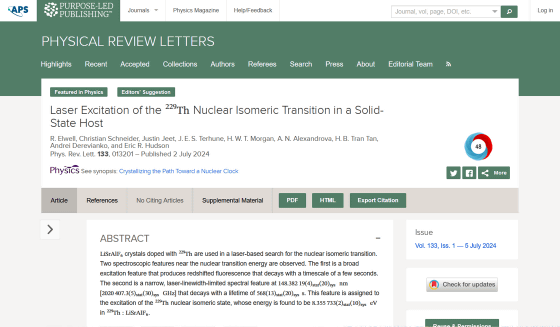Successfully embedding thorium atoms in a transparent crystal and exciting the nucleus with a laser, which may lead to the development of more accurate atomic clocks

A research team from
Phys. Rev. Lett. 133, 013201 (2024) - Laser Excitation of the Th-229 Nuclear Isomeric Transition in a Solid-State Host
https://journals.aps.org/prl/abstract/10.1103/PhysRevLett.133.013201

Nuclear spectroscopy breakthrough could rewrite the fundamental constants of nature | UCLA
https://newsroom.ucla.edu/releases/nuclear-spectroscopy-breakthrough-could-rewrite-fundamental-constants-of-nature
Physicists' laser experiment excites atom's nucleus, may enable new type of atomic clock | NSF - National Science Foundation
https://new.nsf.gov/news/physicists-laser-experiment-excites-atoms-nucleus
The technology of using lasers to measure the energy of atoms and molecules with high precision is used in atomic clocks and chemical analysis, etc. For example, existing atomic clocks measure the change in energy of electrons surrounding elements such as cesium , making it possible to measure the passage of time with high precision.
Since the protons and neutrons that make up the atomic nucleus are heavier and more stable than electrons, it is expected that if we could measure the energy changes of the atomic nucleus, we could develop a more accurate atomic clock. However, because the electrons surrounding the atomic nucleus are easily reactive to light, it has been difficult to excite the nucleus with a sufficient amount of laser.
So a research team led by Eric Hudson, a physicist at the University of California, Los Angeles, experimented with a technique in which a thorium isotope called 'thorium 229' was embedded in a transparent crystal rich in fluorine and excited with a laser.
Fluorine forms strong bonds with other atoms, exposing the thorium-229 nucleus 'like a fly caught in a spider's web.' At the same time, fluorine also binds strongly to electrons, increasing the amount of energy required to excite the electrons. This allows more laser light to reach the thorium-229 nucleus without being blocked by the electrons.
Using this method, the team was able to actually excite the thorium-229 nucleus with a laser and measure the amount of energy it produced. 'Until now, we've been unable to cause this nuclear transition with a laser,' said Hudson. 'By immobilizing the thorium in a transparent crystal, we can now interact with the thorium using light.'

According to Hudson, this technology can be used anywhere that requires extremely accurate time measurement, such as in sensors, communications, and navigation. Existing atomic clocks based on electrons are large, requiring vacuum chambers and cooling systems to confine the atoms, but thorium-based atomic clocks are more accurate, smaller, more robust, and easier to carry.
It is also expected that measuring the excitations of atomic nuclei with high sensitivity will enable more detailed testing of the laws of matter, energy, space, time, etc. Hudson said, 'From our limited perspective, the world is a collection of effects at different scales of size, time, and energy, and the constants of nature that we formulate seem to hold at this level. But if we could observe more precisely, these constants might change! Our research is a big step towards such measurements. Either way, I have no doubt that we will be surprised by what we find.'
Related Posts:
in Science, Posted by log1h_ik







